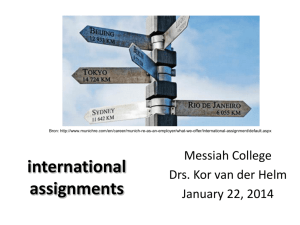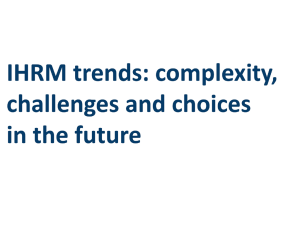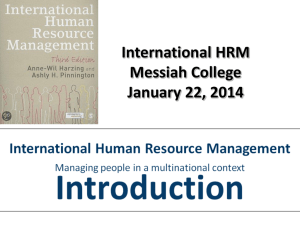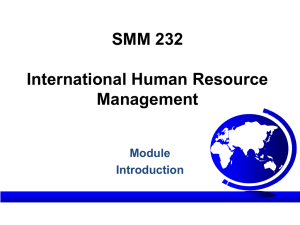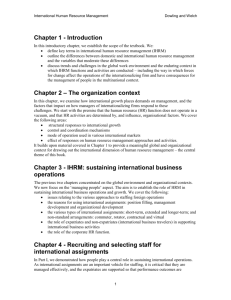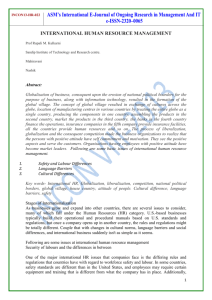2 Evolution of IHRM
advertisement
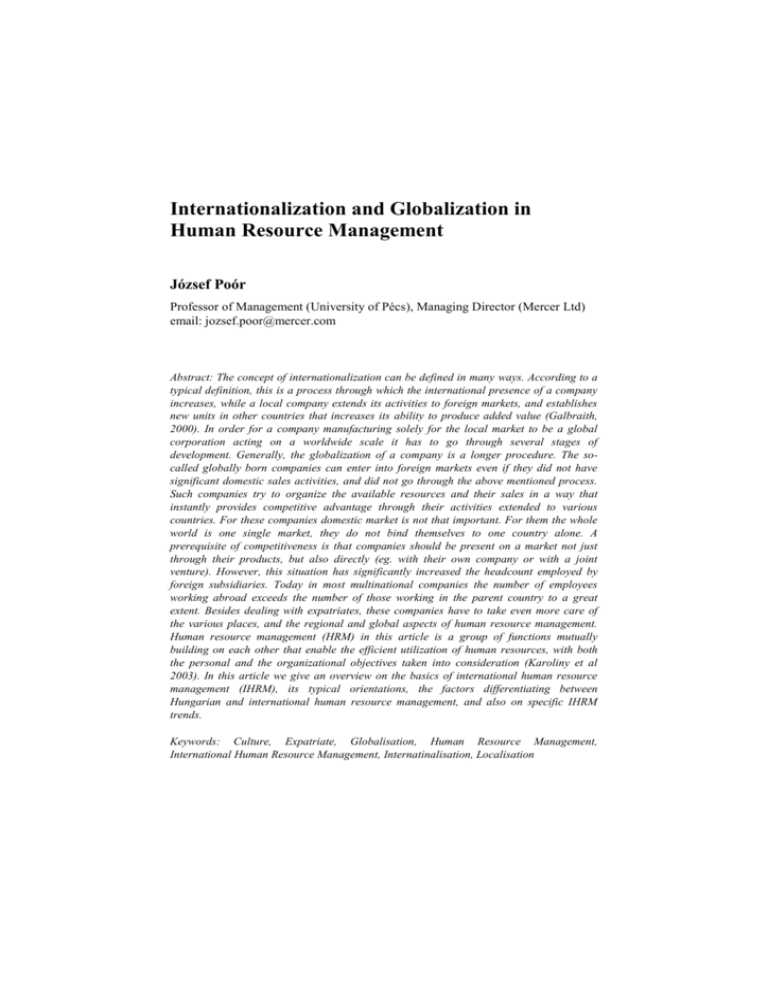
Internationalization and Globalization in Human Resource Management József Poór Professor of Management (University of Pécs), Managing Director (Mercer Ltd) email: jozsef.poor@mercer.com Abstract: The concept of internationalization can be defined in many ways. According to a typical definition, this is a process through which the international presence of a company increases, while a local company extends its activities to foreign markets, and establishes new units in other countries that increases its ability to produce added value (Galbraith, 2000). In order for a company manufacturing solely for the local market to be a global corporation acting on a worldwide scale it has to go through several stages of development. Generally, the globalization of a company is a longer procedure. The socalled globally born companies can enter into foreign markets even if they did not have significant domestic sales activities, and did not go through the above mentioned process. Such companies try to organize the available resources and their sales in a way that instantly provides competitive advantage through their activities extended to various countries. For these companies domestic market is not that important. For them the whole world is one single market, they do not bind themselves to one country alone. A prerequisite of competitiveness is that companies should be present on a market not just through their products, but also directly (eg. with their own company or with a joint venture). However, this situation has significantly increased the headcount employed by foreign subsidiaries. Today in most multinational companies the number of employees working abroad exceeds the number of those working in the parent country to a great extent. Besides dealing with expatriates, these companies have to take even more care of the various places, and the regional and global aspects of human resource management. Human resource management (HRM) in this article is a group of functions mutually building on each other that enable the efficient utilization of human resources, with both the personal and the organizational objectives taken into consideration (Karoliny et al 2003). In this article we give an overview on the basics of international human resource management (IHRM), its typical orientations, the factors differentiating between Hungarian and international human resource management, and also on specific IHRM trends. Keywords: Culture, Expatriate, Globalisation, Human Resource Management, International Human Resource Management, Internatinalisation, Localisation 1 Basics More than 40 years ago Fayerweather (1960), and some years later Bormann (1968) wrote about the difficulties of expatriates in different cultures. But it is also important to emphasize that for a very long time in publications only foreign trade, investment and marketing aspects had an outstanding role in relation to the globalization of companies. Until now the most influential theory of international human resource management was published by Perlmutter in 1969. According to this author the IHRM practice of various multinational companies is largely depending on how their local human resource management practice (ethnocentric) is followed abroad, or how they adapt to the local (polycentric), regional (regiocentric) and global (geocentric) conditions. The earlier state of IHRM studies can be well described by one single sentence taken from Laurent (1986): "If HRM is in its infancy, then IHRM is still a newborn baby." The need for an independent international human resource management (IHRM) was expressed clearly only in the 1980's (Dowling, 1986; Morgan, 1986, Ackermann, 1991, Domsch-Lichtenberg, 1991). In their latest book the authors Dowling-Welch (2004) state that the model of IHRM can be described along three dimensions: The broader category of the typical activities of HRM (recruitment, expatriation and further employment). Those larger categories of countries, where the IHRM activities are carried out (parent country, target and host country, other countries) Country categories and origins of larger groups of employees (parent, target or host, third country nationals) Adler and Ghader (1990) believe that international HRM has a close relation with the fact that a company enters into the international market (exports, representation, joint venture, whole-owned company). Taylor et al (1996) and Lado-Wilson (1994) state that IHRM can contribute to the development of multinational companies with the development of personal competencies. Brewster-Hilary (1999) say that IHRM is much more than arranging HRM issues of expatriates in an international context. They believe that IHRM deals with the worldwide management of human resources. The most well-known HRM books and some business management books also touching on human resource management from the German-speaking area (Hentze-Kammel, 2001; Haubrock, 2004; Scherm-Süss, 2003; Jung, 2004) do not talk about human resource issues arising from globalization. Other manuals or trade books from the same area (Franke-Bodon, 2003; Olfert, 2003; Hentze, 1995) discuss HRM, intercultural management and the issue of expatriates as an element of globalization strategies. Representatives of various Hungarian HRM schools (Kővári, 1995; Gaál, 1999; Gyökér, 1999; Bakacsi et al, 2000; Tóthné, 2000; Pálinkás-Vámosi, 2002; Roóz, 2002) do not pay special attention to the international aspects of HRM. Although the situation has been changing recently as a result of various research studies on culture (Bakacsi et al, 2002; Borgulya-Barakonyi, 2004; Jarjabka, 2003), communication (Borgulya, 2004) and international management (Simai - Gál, 2000; Poór-Farkas, (eds), 2001). As a result of the work of the HRM team in Pécs, established by the author, the first extensive handbook on the topic appeared in 1996 (Poór et al, 1996) and since 1999 the HRM aspects of globalization are mentioned separately in the handbook on Hungarian HRM (Poór et al, 1999; Karoliny et al, 2003). According to studies international human resource management covers different functions. For a long time authors mainly examined the recruitment and assignment of expatriates, and also how their repatriation can be assured. There were significant research activities regarding this topic, where researchers mainly examined issues related to the recruitment, remuneration, benefits and labor contracts of expatriates. It is clear from references in the studies that by now the situation changed significantly, and researchers widened the scope of their surveys – although differently in terms of detail and attention – to cover new topics, such as global values, organizational culture, intercultural communication, and – last, but not least – HRM issues related to the local employees. 2 Evolution of IHRM Regarding evolution of IHRM Evans et al (2002) state that three distinct phases can be identified in the history of this field. The first, so-called pre-scientific period covers nearly 2000 years and lasted until the beginning of the 20 th century. In this period there were already some international ventures (eg. the East-Indian Corporation, or the shipping companies), but during these years IHRM was not in the focus of management attention. According to the above author the beginning of the first real era of IHRM dates back to the period when the first companies established their offices and subsidiaries abroad. At the beginning of World War I dozens of companies operated already on an international field. The globalization of business forced companies to send expatriates into management or consultant positions to their foreign concerns. By the 1960's the 180 examined American companies had an average of 6 subsidiaries abroad (Evans et al, 2002). This significant growth urged companies to increase the number of their expatriates to a great extent. War veterans, who spoke foreign languages, were not always the appropriate persons, who would be able to transfer knowledge and experience abroad. In this period it became clear that in order to be successful in globalization it is indispensable to adapt to various national cultures. In the above period knowledge sharing between headquarters and foreign concern had a typical hierarchical form. The direction of knowledge flow was from headquarters or regional centers to subsidiaries. The fast, and sometimes not well-considered human resource management soon had its consequences. A survey made by Tung (1982), often quoted in IHRM studies, showed that several expatriates caused many difficulties to the parent companies. In many cases the work performance of local subsidiaries deteriorated or became impossible as a result of the activities of the expatriates. IHRM became a university discipline in this period (Evans, 2002), and Hofstede (1980) published his culture theory, that is still popular today. The third period of IHRM started at the end of the 1980's, when globalization became even stronger. As a result of globalization companies were striving even stronger to implement network-based solutions, instead of hierarchical knowledge transfer and coordination. A special feature of this localization procedure was that the HRM departments were mainly led by locals even at the time when other management positions were rather filled by foreign managers. Besides expatriates more and more inpatriates appeared in multinational companies (that is, locals delegated from subsidiaries to headquarters). In the 1980's many multinational corporations recognized, that their decision-making system needs some restructuring. This led to the reduction of the headcount of oversized units in headquarters, and also to the reduction of the number of expatriates. Local experts with a better understanding of local culture got more significant roles. The localization process first became stronger in the developed countries, where very expensive expatriates were gradually sent home and replaced by locals. In the 1990's HRM and IHRM supported many restructuring procedures and brought this function closer to management. As a result of the new tasks, new techniques had to be worked out. This was the time when – besides job/position-based HRM – the methods of person-based (or competence-based) human resource management appeared. 3 Factors Differentiating between Local HRM and IHRM Further on, we will examine what are the most important factors that could explain the differences between domestic HRM and international IHRM. 3.1 Expatriates A very strong differentiating factor between domestic and international HRM is the existence and role of the so-called expatriates, who move from country to country, and there, having an employment for a shorter or longer time period, become the residents of the receiving country. The concept of the traditional expatriate has been extended in several countries, and in many companies they are started to be called as "international assigners". Another new concept also appeared relating to the assignment of locals from the receiving country to the parent country, and recently they are called inpatriates (Dowling-Welch, 2004). 3.2 More HR Activities HR departments of companies operating in an international environment have to perform several activities that are not necessary at all on a domestic level. A classical example in IHRM textbooks is the international taxation, which means that HR departments have to be familiar not only with the taxation of domestic incomes, but also with practices in those countries, where the expatriates of the company are working. 3.3 More Insight into the Private Life of Employees The HR departments of companies operating in several countries all over the world, with respect to the internal management and decision processes, extend their attention to all affected countries, and to all employees supervised directly (eg. managers and the management candidates as well). Information technology today provides an almost personalized tracking possibility. Under this we mean the global human resource databases and employee satisfaction surveys conducted on a global scale with the support of IT. There is a larger interference with the private life of employees. This is an interesting and special issue of international IHRM. This characteristic feature of the field is related to the fact that often the failure of expatriates is not caused by their poor performance, but the improper adaptation of their family members (Dowling-Welch, 2004). So, multinational companies start to put large emphasis on the family members and eventually on their specific needs already in the selection phase. 3.4 Maturity Phase of a Foreign Subsidiary I have already examined in various publications (Bangert-Poór, 1993, 1995) how changes in the maturity of the local subsidiary affect its management and its human resource policy. From our aspects we would like to emphasize the process of localization only, which means that as the management and employees of a local subsidiary become more and more experienced, the parent company gradually repatriates or relocates the foreign human resource, that is much more expensive than the locals (Dowling-Welch, 2004). Another characteristic feature of the maturity of a subsidiary can be when several local employees are transferred into an inpatriate status, mentioned previously, while others get foreign assignments in a region close to the local subsidiary (eg. Eastern Europe). 3.5 Employment Risks The eventual failure of expatriates can largely be due to the special risk factors of a country's environment arising during an assignment. For a long time, countries of the third world were pioneers in this respect, while after 11 September 2001 this issue was seen from a different angle. The threat of terrorism soon appeared in developed countries as well. 3.6 Specific Impacts of the External Environment Various countries behave differently towards multinational companies. Very often they provide a large degree of freedom for them, while in other cases (eg. in the Czech Republic) they require a language exam even for expatriates having a formal labor permit In the above paragraphs we tried to explain – without aiming to give a full picture – that for companies operating in an international environment human resource management has several special characteristics. Among those are the following: International human resource management – compared to a purely domestic HRM – is more complex and requires the consideration of much more factors, due to the very different places of its application and the different legal and cultural environments. Several functions of human resource management (planning, administration, planning and analysis of jobs) are the same, but some activities need to be extended in line with the special requirements of the international operation. Here we can mention, that eg. not only the employee, the future expatriate needs to be known, but also his/her family. Are there kids? How old are they? Do they need special health care? In the majority of the cases foreign companies have a more developed human resource operation, than the locals do. They apply especially efficient methods on the field of work performance, communication, induction of new employees and career management, while local companies concentrate mainly on human resource tasks related to collective bargaining and strikes (Hiltrop, 1991; Poór-Roberson, 2003). 4 The human resource management models of companies operating in different legal, institutional and economic environments cannot be completely standardized. Therefore it is important to highlight, that the practice established in the environment of the parent country has to be adjusted to the economic, legal and political relations and culture of the country hosting the subsidiary. IHRM from the Aspect of the Local Subsidiary In different management cultures (Fahy et al, 2003) we can see that multinational companies led by foreign management overperform local companies. If we take a closer look at the various research materials it is also evident that there are several interesting phenomena behind this general statement. For example, the successes of large multinational corporations usually can be explained by the optimal balance they manage to find between global standardization and efficient local responses (Bartlett-Ghoshal, 2000). In those cases where the excellent knowledge of domestic customers was crucial in giving the appropriate responses in line with local requirements, it happened very often, that local companies defeated their multinational rivals (Fahy et al, 2003). Foreign companies are much more efficient in transferring tangible resources (money, brand) than the locals, while locals are better in realizing the so-called softer capabilities. If we link this statement to the knowledge management concept (Polányi, 1976; and others), then the above statement will also mean that probably multinational companies are able to transfer the explicit management knowledge – eg. job evaluation system, job description, etc. – that is easy to encode, in a much better and more efficient way to the local staff. However their competitive advantage is not that significant in terms of knowledge that is difficult to encode. The effects of the role and strength of foreign capital in the management of local subsidiaries are influenced by several social, economic and historical specialities (Wild et al, 2003; Fatehy, 1995; Hill, 2003). Researchers also identified several differences among the Eastern European countries. These differences were demonstrated on the field of marketing (Rekettye-Fojtik, 2004), corporate strategy (Barakonyi, 2004), company culture (Barakonyi-Borgulya, 2003) and human resource management (Koubek-Vatckova, 2004; Alas-Svetlik, 2004), as well. In respect of our topic it is important to mention that, besides the above listed general characteristics, the role of foreign capital is also influenced by the function of FDI in the country of the survey. At the time when the survey was conducted the Hungarian, Polish and Czech advantages in terms of time and volume made the differences between the practices of local and multinational companies more apparent, if we make a comparison with countries like Slovenia or Romania, where the presence of multinationals is still much smaller. Russia should be discussed separately. As a result of tradition, size and culture this country shows a completely different picture in restructuring corporate management and the HR function. The entry and settlement of foreign companies is much slower and the process is much longer here. Parallel with this, the restructuring of companies is also much slower (Morgan-Thorpe, 2001), but due to the size of the country the profit outlook on the long term is much more promising. References [1] Ackermann, K. F. (1991): Strategisches Personalmanagement im Visier der Wissenschaft. In: Ackermann, K. F.- Scholz, H.: Personalmanagement für 90er Jahre. Stuttgart [2] Adler, N.- Ghader, F. (1990): Human Resource Management: A Global Perspective Human Resource Management in: Pieper, R.: International Comparison. Walter de Gruyter, Berlin [3] Alas, R.- Svetlik, I. (2004): Estonia and Slovenia: Building Modern HRM Using a Dualist Approach. In: Brewester, C.- Mayrhofer, W.- Morley, M.(eds.): Human Resource Management in Europe Evidence of Convergence? Elsevier, London [4] Bakacsi et al (2000): Strategic Human Resource Management. (In Hungarian) Közgazdasági Jogi Könyvkiadó-Kerszöv, Budapest [5] Bangert, D. C.- Poór J. (1995): Human resource management in foreign affiliates in Hungary. In: Shenkar, O. (ed.): Global Perspectives of Human Resource Management. New Jersey: Prentice Hall [6] Barakonyi K.- Borgulya I-né ( 2003): Company Culture. (In Hungarian). Nemzeti Tankönyvkiadó, Budapest [7] Borgulya I. (2004): Inter-cultural Communication. (In Hungarian) PTE KTK, Pécs [8] Borgulya I. – Barakonyi K. (2004): Vállalati kultúra. Nemzeti Tankönyvkiadó, Budapest [9] Bormann, W. A. (1968): Personalwirtschaftliche internationalen Unternehmungen. Diss. München [10] Brewester, C. – Hilary, H. (eds.) (1999): International HRM. Routeledge, London [11] Domsch, M. - Lichtenberger, B. (1991): Konsequenzen der Internationalisierung für das Personalmanagement. Gabler’s Magazin, No. 2, pp. 21-25 Sonderprobleme [12] Dowling, P. J. (1986): Human Resource Issues in International Business. Syracuse Journal of International Law and Commerce, Issue 2, pp. 255-271 [13] Dowling, P. J. - Welch, D. E. (2004): International Human Resource Management. Thomson, London [14] Evans, P. - Pucik,V.-Barsoux, I - L. (2002). The Global Challenge. McGraw-Hill, Irvin [15] Fahy, J. - Hooley, G. - Berács J. - Fonfara, K. - Gabrijan, V. (2003): Privatisation and Sustainable Competitive Advantage in the Emerging Economies of Central Europe. Management International Review, No. 4, pp. 407-428 [16] Fatehi, K. (1996): International Management. Prentice Hall, New Jersey [17] Fayerweather, J. (1969): International Business Management – A Conceptual Framework. New York [18] Franke, D. - Boden, M. (eds.) (2003): Personaljahrbuch. 2004. Wolters Kluwer, Neuwied [19] Gaál Z. (1999): Human Capital – Organizational Culture. (In Hungarian) Harvard Business Manager, No. 1. pp. 69-74 [20] Gyökér I. (1999): Human Resources management. (In Hungarian) Műszaki Könyvkiadó-Magyar Minőség Társaság, Budapest [21] Haubrock, A. (2004): Personal-management. W. Kohlhammer, Stuttgart [22] Hentze, J. (1995): Personalwirtschaftslehre 2. Paul Haupt, Bern [23] Hentze, J. - Kammel, A. (2001): Personalwirtschaft3slehre. Haupt, Bern [24] Hill, C. W. L. (2002): Global Business. McGraw-Hill, Boston [25] Hiltrop, J. M. (1991): Human Resources Practices of Multinational Organizations in Belgium. European Management Journal, No. 4, pp. 404411 [26] Hofstede, G. (1980): Culture’s Consequences: International Differences in Work – Related Values, Saga, Beverly Hills [27] Jarjabka Á. (2003): Hungarian Nattional Culture – Organisation Culture in Hofste’s Model. (In Hungarian) Marketing & Menedzsment, XXXVII. évf. 1. sz., pp. 29-45 [28] Jung, H. (2004): Allgemeine Betriebswirtschaftslehre. Oldenbourg, München [29] Karoliny M-né - Farkas F. - László Gy. - Poór J. (eds.) (2003): Human Resources Management. (In Hungarian), 4. Kiadás, Közgazdasági Jogi Könyvkiadó-Kerszöv, Budapest [30] Koubek, J. - Vatckova, E. (2004): Bulgaria and Czech Republik: Countries in Transition. In: Brewester, C. - Mayrhofer, W. - Morley, M. (eds.): Human Resource Management in Europe Evidence of Convergence? Elsevier, London [31] Laurent, A. (1986): The Cross-Cultural Puzzle of International Human Resource Management. Human Resource Management, No. 1, pp. 91-102 [32] Lado, A. – Wilson, M. (1994): Human resource systems and sustained competitive advantage - a competence-based perspective. Academy of Management, Review, Vol. 19, pp. 699 – 727 [33] Morgan, R. E. - Thorpe, E. R. (2001): Foreign Direct Investment in Transition Economies The Case of Coca-Cola in Russia. Journal of Euromarketing, No. 1, pp. 27-48 [34] Olfert, K. (2003): Personalwirtschaft. Kiehl, Ludwigshafen [35] Pálinkás J. – Vámosi Z. (2002): Human Resource Management. (In Hungarian) LSI Oktatóközpont, Budapest [36] Polányi, M. (1967): The tacit dimension. Anchor Publishing, Garden City [37] Poór, J. (1996): International Human Resource management. (In Hungarian). Közgazdasági és Jogi Könyvkiadó, Budapest [38] Poór J. (1999): Major Developments in Human Resources Management. IHRM Journal, September, pp. 95-98 [39] Poór J - Farkas F. (eds) (2001): International Management. (In Hungarian) Közgazdasági és Jogi Könyvkiadó, Budapest [40] Rekettye G. -Fojtik J. (2004): International marketing. (In Hungarian) Dialóg-Campus Kiadó,Budapest-Pécs [41] Roóz J. (2002): Business Economics. (In Hungarian) Perfekt Kiadó, 2Budapest [42] Simai M. - Gál P. (2000): New Trends and Strategies in World Economy. (In Hungarian) Akadémia Kiadó, Budapest [43] Taylor, S. – Beechler, S. – Napiev, N. (1996): Towards an integrative model of strategic international human resource management. Academy of 9Management , Review, Issue 4, pp. 959 –985 [44] Tung, R. (1981): Selection and Training of Personnel for Overseas Assignments. Columbia Journal of World Business, vol. 16, pp. 68-79 [45] Wild, J. J. – Wild, K. L. – Han, J. Cy. (2003): International Business. Prentice Hall, New Jersey
